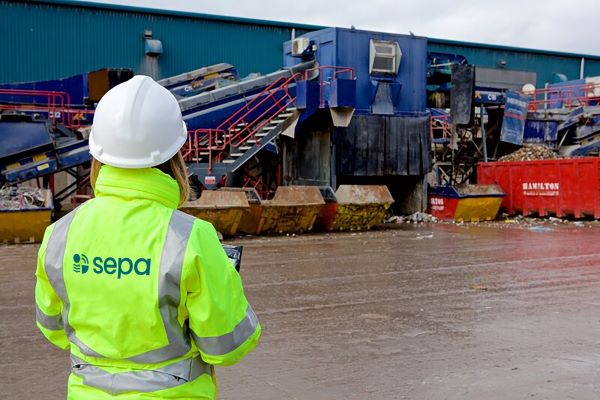Important changes are happening in environmental regulation in Scotland. Scott Crawford, Senior Permitting Manager at the Scottish Environment Protection Agency (SEPA), explains what the changes are and what this means for regulated businesses in Scotland.
At the start of November, the regulation of water, waste management and industrial activities moved under the Environmental Authorisations (Scotland) Regulations 2018 (EASR). This provides a streamlined environmental regulatory framework, simplifying the processes for authorising, enforcing and managing activities that may impact the environment.
Previously, only radioactive substances activities were regulated under EASR, but recent amendments extend the framework to now include water, waste management and industrial activities. The joined-up approach provided by the regulations is designed to support more effective and efficient regulation; reducing regulatory burden and ensuring consistency in how SEPA regulates.
The changes took effect from 1st November and will change the way that SEPA authorise and regulate activities.
What’s does this change mean for existing authorisations?
The Environmental Authorisations (Scotland) Regulations 2018 has replaced eight different regulations. These are:
- The Water Environment (Controlled Activities) (Scotland) Regulations 2011 (CAR)
- Pollution Prevention & Control (Scotland) Regulations 2012 (PPC)
- The Waste Management Licensing (Scotland) Regulations 2011
- Controlled Waste (Registration of Carriers and Seizure of Vehicles) Regulations 1991
- Sludge (Use in Agriculture) Regulations 1989
- Special Waste Regulations 1996
- End-of-Life Vehicles (Storage and Treatment) (Scotland) Regulations 2003
- Landfill (Scotland) Regulations 2003
If you or your business currently holds an authorisation under any of the regulations listed above, the move to EASR may affect you.
Most existing authorisations have automatically become EASR authorisations, and in most cases the conditions of your authorisation will stay the same. But for some, the authorisation conditions have changed, or you might need to apply for a new authorisation to remain compliant.
What you need to do will depend on the type of existing authorisation you have and the activity you’re doing.
Applying for a new EASR authorisation
Types of authorisation
New types of authorisation have been brought in under EASR. This means the type of authorisation required better reflects the risk of harm an activity poses to the environment and human health, with more assessment and tighter controls in place for activities that pose a higher risk. There are four different types, which are used for all activities, regardless of whether the activity is related to water, waste management, industrial activities or radioactive substances. These are General Binding Rules (GBRs), notifications, registrations and permits.
All authorisations have conditions or rules that must be complied with. For registrations, these are standard conditions. The same standard conditions are applied to the same type of activities. By applying consistent conditions to similar activities, a level playing field is created for operators and regulatory inconsistencies are removed. This approach not only improves transparency but also helps SEPA support businesses to make informed decisions before carrying out a regulated activity while still ensuring the environment is protected.
All standard conditions were consulted on last year and have been written to be enforceable, transparent and proportionate to the risk to the environment. Once published, they cannot be appealed and can only be changed following further consultation. If the person wishing to carry out a registration activity cannot comply with the associated standard conditions, they may have to apply for a permit instead.
For permits, the conditions are tailored to your specific activity and location and will be determined during the assessment of your application. This is to ensure appropriate safeguards are in place to minimise pollution and protect the environment.
In control and Fit and Proper Person test
Whether applying for a new registration or a permit, applicants will now be subject to an assessment of whether you are suitable to hold an authorisation.
Before SEPA grant an EASR authorisation, they will assess if the applicant is the person in control of the activity and if they are a fit and proper person to be in control. This helps ensure regulated activities are carried out following the conditions in an authorisation and the environment is protected.
These assessments are not tick box exercises; they are a balanced judgement and take account of the outcomes SEPA wants to achieve and certain criteria, such as compliance history, relevant convictions held by you or any individuals involved in your operation, and technical competence. The overall purpose and process is consistent across all regulated activities, and SEPA will evaluate both the environmental risk of the activity and the applicant’s attitude toward compliance.
If authorisation is granted, the authorised person must maintain their fit and proper status throughout the lifetime of the authorisation.
Next steps for businesses
It’s important to find out and understand how your existing authorisation has transitioned to EASR. If you do need to apply for a new authorisation, plan ahead and prepare to avoid any disruption to your operations.
Read SEPA’s Navigating regulatory change guide and visit the SEPA website for more detailed information on how your authorisation has transitioned to EASR.
You can also find descriptions of all activities and the type of authorisation that applies to each, that will be regulated under EASR and information on how to apply for a new authorisation.
If you need help navigating the changes, get in touch with SEPA for guidance and support and to talk through your options.






